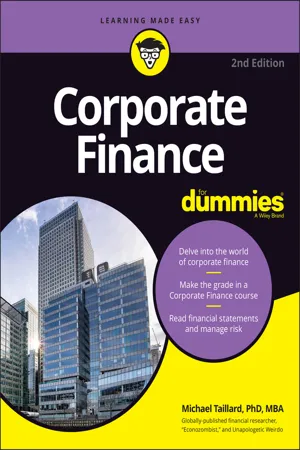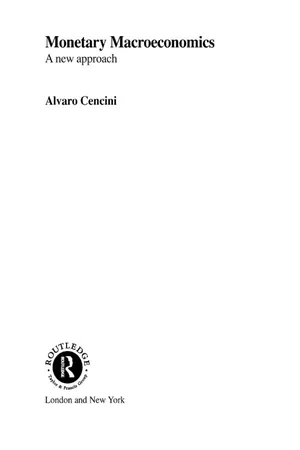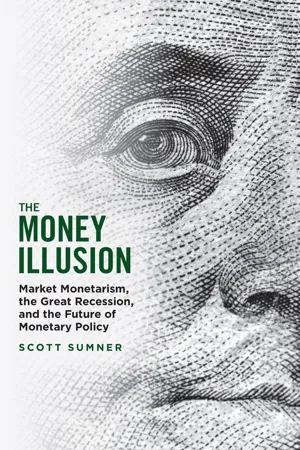Economics
Real vs Nominal Value
Real value refers to the value of a good or service adjusted for inflation, while nominal value refers to the value of a good or service without any adjustment for inflation. Real value takes into account the purchasing power of money, while nominal value does not.
Written by Perlego with AI-assistance
Related key terms
5 Key excerpts on "Real vs Nominal Value"
- eBook - ePub
- Michael Taillard(Author)
- 2021(Publication Date)
- For Dummies(Publisher)
Real value is measured by the ability of money to be exchanged for other things. In other words, real value refers to the purchasing power of money, which includes nominal value plus inflation. (See the section on inflation for more details.)- In nominal terms: Nominal value is very easy to measure because it’s simply a measure of the number of units of currency you have — that is, the volume of money. For instance, $10 will always have a nominal value of $10. A $1 coin, even if it’s made of pure diamond and is sought after by collectors for billions of dollars, still has a nominal value of just $1.
Only the real value of money, not the nominal value, is influenced by time. So, $10 will still be $10 next year (its nominal value), but it’ll purchase less than it does this year (its real value). This distinction is very important because the goal of corporations is to ensure that their nominal value increases faster than the real value of each unit of currency decreases. In other words, they want to make more money faster than the money they have loses its value.The following sections take a look at the two main factors that cause money to change real value over time.Inflation
Inflation is when a currency’s ability to purchase goods (that is, its purchasing power) is diminished — that is to say, when its purchasing power decreases, causing people to spend more units of currency to acquire an equal quantity of goods.The three forms of inflation are- Cost push: The cost of production increases, raising prices. For example, a drought might force farmers to spend more money on water to grow corn, forcing them to increase prices in order to avoid losing money.
- Demand pull:
- Smith, Adam(Authors)
- 2010(Publication Date)
- pubOne.info(Publisher)
But though equal quantities of labour are always of equal value to the labourer, yet to the person who employs him they appear sometimes to be of greater, and sometimes of smaller value. He purchases them sometimes with a greater, and sometimes with a smaller quantity of goods, and to him the price of labour seems to vary like that of all other things. It appears to him dear in the one case, and cheap in the other. In reality, however, it is the goods which are cheap in the one case, and dear in the other.In this popular sense, therefore, labour, like commodities, may be said to have a real and a nominal price. Its real price may be said to consist in the quantity of the necessaries and conveniencies of life which are given for it; its nominal price, in the quantity of money. The labourer is rich or poor, is well or ill rewarded, in proportion to the real, not to the nominal price of his labour.The distinction between the real and the nominal price of commodities and labour is not a matter of mere speculation, but may sometimes be of considerable use in practice. The same real price is always of the same value; but on account of the variations in the value of gold and silver, the same nominal price is sometimes of very different values. When a landed estate, therefore, is sold with a reservation of a perpetual rent, if it is intended that this rent should always be of the same value, it is of importance to the family in whose favour it is reserved, that it should not consist in a particular sum of money. Its value would in this case be liable to variations of two different kinds: first, to those which arise from the different quantities of gold and silver which are contained at different times in coin of the same denomination; and, secondly, to those which arise from the different values of equal quantities of gold and silver at different times.Princes and sovereign states have frequently fancied that they had a temporary interest to diminish the quantity of pure metal contained in their coins; but they seldom have fancied that they had any to augment it. The quantity of metal contained in the coins, I believe of all nations, has accordingly been almost continually diminishing, and hardly ever augmenting. Such variations, therefore, tend almost always to diminish the value of a money rent.- eBook - ePub
- Adam Smith(Author)
- 2019(Publication Date)
- Otbebookpublishing(Publisher)
But though equal quantities of labour are always of equal value to the labourer, yet to the person who employs him they appear sometimes to be of greater, and sometimes of smaller value. He purchases them sometimes with a greater, and sometimes with a smaller quantity of goods, and to him the price of labour seems to vary like that of all other things. It appears to him dear in the one case, and cheap in the other. In reality, however, it is the goods which are cheap in the one case, and dear in the other.In this popular sense, therefore, labour, like commodities, may be said to have a real and a nominal price. Its real price may be said to consist in the quantity of the necessaries and conveniencies of life which are given for it; its nominal price, in the quantity of money. The labourer is rich or poor, is well or ill rewarded, in proportion to the real, not to the nominal price of his labour.The distinction between the real and the nominal price of commodities and labour is not a matter of mere speculation, but may sometimes be of considerable use in practice. The same real price is always of the same value; but on account of the variations in the value of gold and silver, the same nominal price is sometimes of very different values. When a landed estate, therefore, is sold with a reservation of a perpetual rent, if it is intended that this rent should always be of the same value, it is of importance to the family in whose favour it is reserved, that it should not consist in a particular sum of money. Its value would in this case be liable to variations of two different kinds: first, to those which arise from the different quantities of gold and silver which are contained at different times in coin of the same denomination; and, secondly, to those which arise from the different values of equal quantities of gold and silver at different times.Princes and sovereign states have frequently fancied that they had a temporary interest to diminish the quantity of pure metal contained in their coins; but they seldom have fancied that they had any to augment it. The quantity of metal contained in the coins, I believe of all nations, has accordingly been almost continually diminishing, and hardly ever augmenting. Such variations, therefore, tend almost always to diminish the value of a money rent. - eBook - ePub
- Alvaro Cencini(Author)
- 2001(Publication Date)
- Routledge(Publisher)
Desai’s true interest seems to lie in the variation of the value of money. His analysis is concerned mainly with ‘the reproductive measure of purchasing power’ (Desai 1995: 301), which he relates to ‘the expected requirements to reproduce last year’s standard of living’ (ibid.: 301). His critical assessment of price indices and of their use as indices of variation in purchasing power is a sign of his concern with the need for a better standard to account for the value of money and its variations in time. Yet, his frequency-related indices of purchasing power do not seem to be up to this task. Although they may be used successfully to determine variations in the cost of living, they tell us nothing about variations in the value of money. The point is that, while an increase in macroeconomic prices defines an equivalent variation in the numerical expression of value, the impact of an increase in microeconomic prices (i.e. those with which price indices are concerned) is confined to a new distribution of income.The value of money and (macroeconomic) prices are determined simultaneously. This seems to be true for classical, neoclassical and modern economists alike. A major difference exists, however, as to the way prices are determined. Whereas within the classical framework prices are absolute and determined by production, in GEA prices are relative and determined through exchange. Now, the attempt to determine prices through relative exchange is seriously jeopardised by the logical impossibility of considering money as a real good. It is obvious that, if prices are relative, money must be conceived of as a commodity. But, if money is a commodity, what is its price? Can a commodity be, simultaneously, the numerical expression of prices and a real good whose price must be expressed in terms of money? Consider the relative exchange between commodity money m and a real good a. If, for example, 10 units of m are exchanged against 1 unit of a, it can equally well be said that 10 units of m are the price of 1 unit of a, or that 1 unit of a is the price of 10 units of m. Thus, m is no more the standard of good a than a the standard of m. Yet, in order for money prices to be univocally determined, it is necessary to have only 1 unit of measure. The problem can be solved neither by choosing one of the two commodities as a reference nor by arbitrarily assuming that it can be taken to be equal to a mere number. Relative exchange can only occur between real terms, a necessary condition which allows neither for the determination of a unique unit of measure nor for the association of numbers with real goods and services. - eBook - ePub
The Money Illusion
Market Monetarism, the Great Recession, and the Future of Monetary Policy
- Scott Sumner(Author)
- 2021(Publication Date)
- University of Chicago Press(Publisher)
monetary phenomenon, were policy makers able to figure out how to get inflation under control. Unfortunately, most economists still don’t recognize the 2008–2009 deflation as also being fundamentally monetary, an oversight I hope to address.So far we’ve defined the value of money in two ways: in terms of foreign exchange rates and in terms of the dollar’s purchasing power over goods and services (1/P). But there are many other definitions as well. Later we’ll see that it might be more useful to define money in terms of a dollar’s ability to buy labor or to purchase a share of nominal GDP.Some people prefer to define the value of money in terms of gold: stable money means a stable price of gold. That doesn’t make much sense today, but before 1933 that definition would have been considered standard. During the period of the gold standard, the 1/P concept that economists now accept was considered an exotic and controversial definition for the value of money.Money Illusion
As I explained in chapter 1 , economists use the term money illusion to refer to cases in which people treat money as a stable measuring stick of value. In his 1928 book The Money Illusion (from which I borrowed the title of my blog and this book), Irving Fisher illustrates this concept with a wonderful example of an American woman who owed money on a mortgage in Germany:The [First] World War came and she had no communication with Germany for two years. After the war she visited Germany, intending to pay the mortgage. She had always thought of it as a debt of $7000. It was legally a debt of 28,000 marks, in terms of German money. She went to the banker who had the matter in charge and said: “I want to pay that mortgage of $7000.” He replied: “The amount isn’t $7000; it is 28,000 marks; that sum today is about $250.” She said: “Oh! I am not going to take advantage of the fall of the mark. I insist upon paying the $7000.” The banker could not see the point; he showed that legally this was not necessary and could not understand her scruples. As a matter of fact, however, she herself failed to take account of the corresponding, though lesser, change in the dollar. She was thinking in terms of American dollars, just as the banker was thinking in terms of German marks. She insisted on paying $7000 instead of paying $250, but she would have rebelled if she had been told that the dollar had also fallen, that the equivalent in buying power of the original debt was not $7000, but $12,000, and that she ought, therefore, to pay $12,000! Then she would not have seen the point!1
Index pages curate the most relevant extracts from our library of academic textbooks. They’ve been created using an in-house natural language model (NLM), each adding context and meaning to key research topics.




